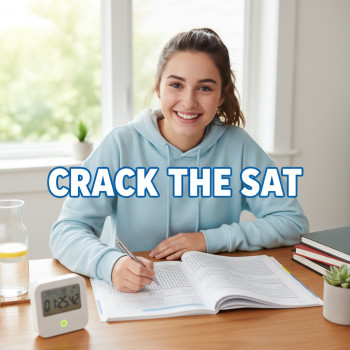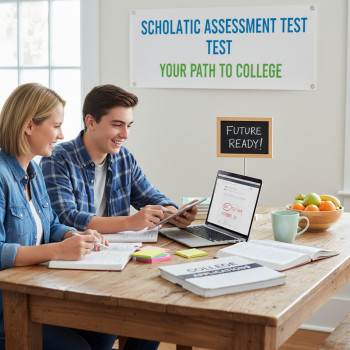Why Self-Assessment Matters More Than You Think
When you think about getting ready for the Digital SAT, most people picture long practice tests, endless flashcards, and a strict study calendar. Those things help, but there’s a quieter, more powerful practice that can change the game: self-assessment. It’s not about being hard on yourself; it’s about being honest and strategic. Self-assessment helps you see patterns in mistakes, recognize what actually improves your score, and spend your time on the moves that matter.
From Guesswork to Precision
Imagine two students. One studies six hours a week using random problem sets; the other spends three hours a week taking targeted practice, reviewing mistakes, and mapping a plan to fix weak areas. Which student will improve faster? Almost always the one who practices with reflection. Self-assessment turns practice into feedback loops. You do a thing, check results, learn why it worked or didn’t, and adjust. That’s how progress compounds.
Key Components of Effective Self-Assessment
Good self-assessment isn’t vague. It breaks study down into measurable pieces, and it asks specific questions after every practice session. Use these components as your checklist:
- Clear, measurable goals: Instead of “get better at algebra,” aim for “improve speed on linear equation questions to solve within 90 seconds on average.”
- Regular, realistic testing: Short daily drills, mixed-section practice, and full-length Bluebook-style practice tests to reflect real conditions.
- Error log: Record each mistake type—concept, careless error, timing, or misunderstanding the prompt.
- Reflection and action: After every practice test ask: What three things can I change before the next session?
- Progress tracking: Use charts or a simple table to compare performance over time so improvements (or plateaus) are visible.
Practical Example: The 3-Step Post-Test Routine
Here’s a tiny routine you can do after any practice section or full test—10 to 20 minutes that anchor your learning.
- Step 1: Triage – Mark problems by reason for error (knowledge gap, misreading, calculator mistake, time pressure).
- Step 2: Fix – For each knowledge gap, write a 1–2 sentence rule or strategy you’ll remember next time.
- Step 3: Re-test – Do 5–10 similar questions within 48 hours to confirm the fix worked.
How to Build a Reliable Self-Assessment System
Don’t overcomplicate it. Your system should be simple enough to keep using, detailed enough to be useful. Below is a ready-to-use framework you can adapt.
Weekly Structure
- Monday: Targeted practice (30–45 minutes) on one weak topic with immediate feedback.
- Wednesday: Timed mixed-section drills (45–60 minutes) to practice transitions and pacing.
- Friday: Review day—go through error log, rewrite rules, and schedule fixes.
- Weekend: Full-length practice test every 2–3 weeks; otherwise, a longer mixed-session practice.
Tools You’ll Use
- Bluebook-style digital practice tests or the official practice app for realistic test format.
- A simple spreadsheet or notebook for an error log and score tracker.
- Flashcards or micro-lessons focused on the most frequent errors you find.
What to Track: A Minimal Error Log Template
Don’t collect data for the sake of collecting it. Track the things that tell you what to change. Here’s a neat table you can copy into a spreadsheet or your notes app.
| Test Date | Section | Question # | Error Type | Root Cause | Fix Planned | Retest Result |
|---|---|---|---|---|---|---|
| 2025-09-01 | Math – Calculator | 12 | Concept | Exponents rules unclear | 4 practice problems + rule note | Correct on retest |
| 2025-09-01 | Reading | 4 | Careless | Skimmed passage | Practice close reading for 10 mins | Partial improvement |
This table does two important things: it forces you to name the root cause (which prevents vague conclusions like “I need to study more”) and it makes fixes concrete and testable.
Interpreting Results: When the Numbers Tell You a Story
Self-assessment becomes powerful when you learn to read trends. A single bad test is a data point. Patterns are the story. Here are common patterns and what they usually mean.
- Sharp spikes in a section: Maybe you were tired, or you guessed poorly. Don’t panic—repeat the test conditions and see if the spike persists.
- Slow, steady decline: This often signals burnout or a flawed study method. Mix up your routine, add short breaks, or seek guided help.
- Improvement without confidence: You might be getting questions right by chance. Focus on explaining each correct answer in your own words.
- Inconsistent timing: Timing issues are common with digital adaptive formats. Practice pacing strategies in timed blocks to stabilize performance.
Example: Turning a Plateau into Progress
Suppose your Evidence-Based Reading score hovers between 560–580 over several tests. Instead of more volume, try targeted micro-practice: annotate one passage a day focusing only on inference questions. After two weeks, reassess. If the plateau persists, bring in an outside perspective—an experienced tutor can spot blind spots faster than you can alone.
How to Use Official Practice to Power Your Self-Assessment
Official, realistic practice is the backbone of honest self-assessment. The digital testing environment has a unique feel—navigation, adaptive sections, and time chunking—that paper tests don’t fully replicate.
Practice Smart, Not Just Hard
- Use digital practice that mirrors the test interface so your comfort with the device and navigation is built in.
- Score and review practice tests exactly as you would on test day: simulate the environment, then do the post-test routine.
- Combine official practice with targeted skill drills. If official items reveal a recurring concept you miss, build a short targeted lesson set and retest.
When to Seek Expert Help—and How to Use It
Self-assessment is powerful, but sometimes you need an experienced outside eye. Tutors or small-group instructors can identify traps in your thinking that are invisible in a personal log. That said, all tutoring is most effective when you come prepared with clear data from your self-assessment.
What an Expert Can Add
- Objective pattern recognition: tutors can quickly spot which mistakes are conceptual vs. strategic.
- Customized practice plans that match your pace of learning rather than a one-size-fits-all schedule.
- Accountability and efficient retesting so you don’t repeat the same mistakes for weeks.
For students who want a blend of self-driven work and targeted guidance, Sparkl’s personalized tutoring can fit naturally into the self-assessment loop—offering 1-on-1 guidance, tailored study plans, expert tutors, and AI-driven insights that analyze your error patterns and accelerate the fix-and-retest cycle.
Study Plan Examples Based on Self-Assessment Results
Below are three compact study plans you can adopt depending on what your self-assessment reveals about your performance.
Plan A — Large Content Gap (e.g., weak foundational math)
- Daily: 30–40 minutes of focused lessons on foundational topics (algebra, ratios, exponents).
- Every 3 days: 20-minute mixed drill on related problem types.
- Weekly: One 60–90 minute review session to consolidate rules and track the error log.
Plan B — Timing & Pacing Issues
- Daily: 20-minute timed drills (5–7 questions, strict time limit).
- Every 4 days: Full timed section practice to rehearse pacing.
- Weekly: Analyze normal vs. rushed errors in your log and practice techniques like strategic skipping and smart flagging.
Plan C — Plateau Despite Correct Answers (confidence issues)
- Daily: Explain two correct answers in writing—one from math, one from reading—focusing on why each wrong choice is wrong.
- Twice weekly: Rapid-fire review of the top five error types to reduce mental friction.
- Weekly: A short full-section practice to check if conceptual understanding is transferring to speed and reliability.
Measuring Improvement: Useful Metrics Beyond Your Score
Score is a big metric—but don’t let it be the only one. Below are other signals that tell you progress is real and sustainable.
- Error-type distribution: Fewer concept errors and more occasional careless errors is a sign you’re learning, not just memorizing.
- Time per question: Reduced average time on question types you previously struggled with.
- Confidence accuracy: Increasing number of correct answers you can verbally explain.
- Retention on retest: Success on retests of the same concept after 7–14 days.
Common Pitfalls in Self-Assessment and How to Avoid Them
Even good systems fail when certain traps show up. Watch for these and use the simple remedies below.
- Pitfall: Overfitting to recent practice — Remedy: Use mixed practice and ensure your error log includes a range of question types.
- Pitfall: Blaming bad days — Remedy: Track conditions (sleep, time of day, breaks) so you can separate situational noise from real trends.
- Pitfall: Ignoring mental skills — Remedy: Add deliberate practice for stamina, stress control, and pacing as part of your plan.
- Pitfall: Too much passive review — Remedy: Always follow up passive reading with active problem solving and retesting.
Real-World Context: How Self-Assessment Helps Beyond Test Day
Learning how to assess your own work is a life skill. The habits you build—data-driven reflection, deliberate practice, targeted fixes—translate to college work, internships, and even early career tasks. Employers notice people who can test an idea, measure results, and iterate fast. Practicing self-assessment for the SAT builds that muscle early.
Quick Case Study
A student struggling with passage-based inference questions started tracking each incorrect inference in a simple spreadsheet. Within three weeks, the student discovered that errors clustered around figurative language and author intent. After targeted mini-lessons and retesting, that student’s reading accuracy on inference questions rose by 18%—and the confidence boost showed up in time management and test-day composure.
Putting It All Together: A 6-Week Self-Assessment Sprint
If you want a focused program to test the power of self-assessment, try this sprint. It’s designed to create a feedback loop that accelerates improvement.
- Week 1: Baseline – Take one full digital practice test in realistic conditions. Log every error.
- Week 2: Target & Fix – Pick top three error types and build daily micro-lessons to address them.
- Week 3: Drill & Retest – Do targeted drills and short timed sections every other day; retest problem areas within 48 hours.
- Week 4: Mixed Practice – Simulate test-day transitions with mixed sections and practice pacing strategies.
- Week 5: Expert Checkpoint – Bring your error log and recent results to an experienced tutor or coach for a review session (this is where Sparkl’s personalized tutoring, with 1-on-1 guidance and AI-driven insights, can help translate patterns into a refined plan).
- Week 6: Final Test & Reflection – Take another full practice test, compare trends, and produce a short action plan for ongoing study.
Final Thoughts: Make Self-Assessment Your Superpower
Preparing for the Digital SAT is as much a practice in learning how to learn as it is a practice in content. Self-assessment is the mechanism that turns time into measurable progress. It keeps you honest, focused, and efficient—so every hour you spend studying moves the needle.
If you pair this approach with smart resources—realistic digital practice, careful error logging, and occasional expert input—you build a system that scales. And if you ever feel stuck or want a coach to translate your data into an action-packed plan, consider a structured tutoring partnership that respects your self-assessment work and enhances it with personalized guidance, targeted lessons, and AI-informed insights.
Quick Checklist to Start Tomorrow
- Take one timed digital practice section and record every error.
- Create an error log entry for each mistaken question with root cause and a planned fix.
- Schedule a 20–30 minute review session within 48 hours to retest fixes.
- Repeat the cycle and review trends weekly—adjust your plan based on evidence, not emotion.
Keep the process honest, be curious about your mistakes, and treat each correction as an investment—not a punishment. Self-assessment isn’t just about a higher SAT score; it’s about learning to get better faster. Start small, track faithfully, and you’ll be surprised how quickly steady reflection transforms your preparation.
Good luck—your future self will thank you.













No Comments
Leave a comment Cancel